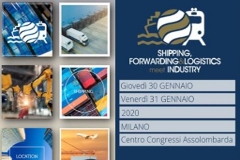
Quarta edizione del "Shipping, Forwarding and Logistics meet Industry", 30-31 Gennaio 2020, Milano.
Il 30-31 Gennaio si svolge a Milano la quarta edizione del "Shipping, Forwarding and Logistics meet Industry", Forum organizzato dal Propeller Club Port of Milan e da Clickutility Team, patrocinato e ospitato da Assolombarda e dalle principali associazioni del settore logistico, portuale ed imprenditoriale oltre che da importanti players dell’industria.
L’evento, articolato in due giornate, mira a presentare le eccellenze dello shipping e della logistica nazionale, a promuovere presso gli stakeholder dei settori industriali i benefici ed i primi risultati generati dal processo di riforma e di rilancio del settore previsto dal piano strategico nazionale della portualità e logistica, nonché a generare opportunità di incontro tra le eccellenze del sistema logistico nazione oltre che con i rappresentanti del mondo industriale e finanziario.
All'evento partecipa anche Planetek Italia. In particolare, rappresentando l'associazione OnData, Massimo Zotti, Head of Government & Security SBU di Planetek, interverrà nelle sessioni di Giovedì 30 Gennaio ore - 14,00 / 18,00:
- "Cryptologistica e Logistica Connessa: stato dell’arte, opportunità e rischi", illustrando "L’utilizzo dei dati di remote sensing per la pianificazione delle aree logistiche".
- "Sostenibilità logistica: dai principi alla realtà e ritorno", illustrando "Strumenti open di telerilevamento per monitorare il consumo di suolo".
In programma un panel di temi che si annuncia quanto mai ricco e articolato: geoeconomia e geopolitica, Via della Seta e Guerra dei Dazi, Brexit e Corridoi Europei Ten T, 5G e innovazione tecnologica, emergenza infrastrutturale e Green logistic.
Per ulteriori dettagli e per partecipare visita https://www.shippingmeetsindustry.it
Timeline
- 2025
- 2024
- 2023
- 2022
- 2021
- 2020
- 2019
- 2018
- 2017
- 2016
- 2015
- 2014
- 2013
- 2012
- 2011
- 2010
- 2009
- 2008

